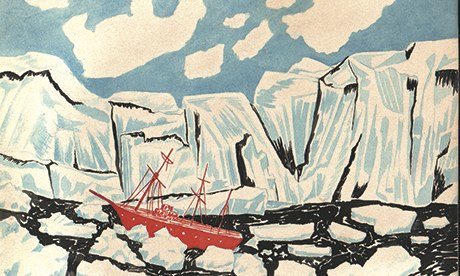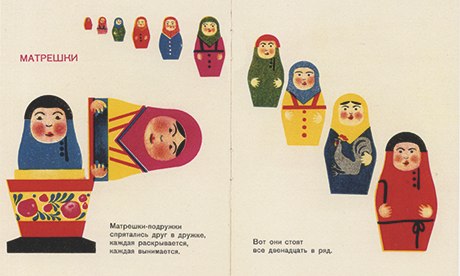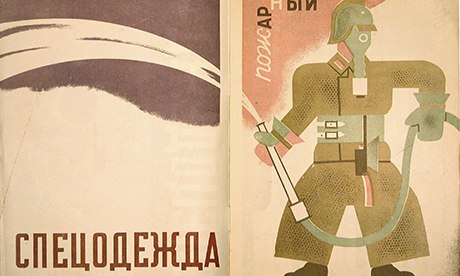How children's books thrived under Stalin
When Stalin's great purges made writing dangerous, a group of avant garde artists turned their attention to children's books. Philip Pullman on a new collection that reveals a vigorous freedom in a time of repression


‘Where is the bear?’ … illlustration from Where Am I? a book of hidden images. Illustration: Tatiana Glebova. Click to enlarge
At the trial of the three Pussy Riot performers in August 2012, one of the accused, Nadezhda Tolokonnikova, made a closing statement in their defence. She spoke of Pussy Riot's admiration for those writers and artists who had suffered under Stalin's purges, and in particular for a group of avant garde poets and writers known as Oberiu. Two of the most prominent Oberiu members were Alexander Vvedensky and Daniil Kharms, both of whom were arrested, and died, during the Great Terror.
Partly because of such collaborations, and partly because children's books provided a hiding place for a while, the early Soviet period was a miraculously rich time for children's books and their illustration. A new book, Inside the Rainbow: Russian Children's Literature 1920-1935 offers a glimpse into that astonishing world. The designer, Julian Rothenstein, and the writer of an essay in the book, Olga Budashevskaya, have produced something truly remarkable. Brilliant primary colours, simple geometrical shapes – at first sight it looks like a textbook of suprematism, the movement that emerged from the intellectual ferment of pre-revolutionary Russia to express the supremacy of pure, artistic feeling above the mere depiction of objects. In the hands of Kazimir Malevich, for example, the great theoretician of suprematism, a black square expressed such feeling, and the white field on which it appeared was the void beyond all feeling.Vvedensky and Kharms had another thing in common. Finding their adult poetry impossible to publish, with its absurdist imagery and aesthetically radical approach, they turned to writing for children. In that field they could earn a living and work without too much interference from the authorities. They could also collaborate with equally avant garde visual artists such as Vladimir Tatlin, the designer of the famous unbuilt Monument to the Third International, and El Lissitzky, the suprematist painter, typographer, and graphic designer.
For the illustrator K Rudakov, in a children's book of 1927, a black square is still a black square, but with the addition of two bells underneath and a hook at the side for the handset, it becomes a telephone. In this picture it's being used by a monkey in red trousers and a black waistcoat, and it illustrates a poem by the great nonsense-poet of Russian children's literature, Kornei Chukovsky (1882-1969).
The illustrations are the main point of Inside the Rainbow, and there are hundreds of them, brilliantly coloured, full of wit and ingenuity, breathtaking in their elegance of form and design. The book covers a period when artists and poets had the sort of freedom that let them produce work like this, but there was always an air of threat in the background. Chukovsky, who wrote about the animals on the telephone, was loved by generations of Russian children, but that didn't save him from criticism, such as this from the psychologist Lev Vygotsky in 1926:
"Chukovsky seems to proceed from the assumption that the sillier something is, the more understandable and the more entertaining it is for the child, and the more likely that it will be within the child's grasp … In his babbling verse Chukovsky piles up nonsense on top of gibberish. Such literature only fosters silliness and foolishness in children."
 Lidia Popova, illustrations for Toys by A Olsufieva, 1928. Photograph: Redstone Press
Lidia Popova, illustrations for Toys by A Olsufieva, 1928. Photograph: Redstone Press
The expression of that cast of mind was a portent of what was to come as the Soviet Union developed and artistic freedom began to wither. The same suspicious attitude to the imagination shows up elsewhere, in a poster on childcare printed for use in creches and nurseries. There is some sensible and humane advice:
"Be careful of any trifle which a child considers a toy, even though it may only be a piece of wood or a stone.
Understand and take part in a child's happiness and sorrow, and he will come to you when he needs you."
But also instructions of a quite different sort:
"Never take a child to motion pictures or the theatre.
Do not tell stories to a child before he goes to sleep, or you will disturb him with new impressions.
Never tell a child about things he cannot see (this means that fairy stories should not be told to children)."
The air of threat later became explicit and deadly, but success as a children's writer did save at least one poet from imprisonment and probably death. The name of the popular writer Samuil Marshak (1887-1964) was on a blacklist until Stalin himself saw it there and crossed it off, saying: "He's a good children's poet."
One poet who wasn't saved was Osip Mandelstam (1891-1938), who was arrested twice under Stalin and died in a transit camp. His poems have become classics, but he features in Inside the Rainbow for his children's book Two Trams of 1925, whose illustrations display great elegance. The artist, Boris Ender, plays with a very limited palette of colours – black, red and grey, with the occasional touch of light brown – and with simplified shapes, especially the recurring sweep of parallel tramlines. It's a lovely example of less doing more.
Before full colour blossomed into British children's books with Brian Wildsmith and John Burningham in the 1960s, the old two-colour printing was common in books for young readers. It was cheap, and at its worst it was deadly dull. In 1920s Russia, however, El Lissitzky, among others, was showing how it could sparkle with modernist brilliance. The black and red of his About Two Squares (1922) are not trying to be anything other than deep black and brilliant red, and they succeed triumphantly, just as they do in his powerful propaganda poster Beat the Whites with the Red Wedge of 1919, a classic example of how to make abstraction instantly readable.
The lithographic process used in many of these examples had a direct influence on the development of children's books in Britain. In 1939 the designer Noel Carrington, a great admirer of Soviet children's books, persuaded Allen Lane to add a Puffin series to the Penguins and Pelicans that had become so successful. Lithography was important here, because by getting the artist to draw directly on to the stone and printing from that, publishers could avoid the time and expense of a photographic stage.
Lithography wasn't the only method featured in these books. Konstantin Kuznetsov's illustrations for I Am a Printer, of 1932, by Ekaterina Zonnenshtral, seem to have been silk-screened: the superb reproduction here allows us to see, by looking closely, the mesh of the screen through which the ink was forced. I know nothing about writer or illustrator, but it's clear that together they produced a book that would have been a delight to handle. The stencilled silhouettes of tractors, locomotives, planes and ships sit on the paper with a varied intensity of ink, in vigorous rhythms that result from careful placing, and with the colours – a rich mustard yellow, deep red, indigo and black – deployed against one another with splendid vigour.
 Boris Ermolenko, cover and illustrations for Special Clothing, 1930 Photograph: Redstone Press
Boris Ermolenko, cover and illustrations for Special Clothing, 1930 Photograph: Redstone Press
Another very striking series of pictures comes from a book called Special Clothing, by Boris Ermolenko (1930). This pre-dates a famous English work of 1938 called High Street, with lithographs by Eric Ravilious, and I have no idea whether Ravilious knew it, but in many respects the two books are similar, not least in the soft ochres, the dusty pinks and greens of the colouring. Special Clothing consists of a series of pictures of workers in the clothing used in their trade: a diver, a baker, a miner, a chemist, and so on.
Like many other illustrations in this collection, Ermolenko's depict their characters in stiff, formal poses, as if to say that it's not the individual that matters, it's their social function. There is a lot of emphasis throughout the collection on how things work, on what people do, on agriculture and transport, on machinery and electricity. One superb picture by Alexander Deineka from The Electrician of 1932, by B Uralsky, shows a worker from behind, arms outstretched, legs firmly apart, just like the figures in Special Clothing; but this man is working high up on an electricity pylon, in the middle of an almost abstract pattern of white wires and insulators glowing against a black sky. He is strong, confident, smiling, holding the future in his hands; "Wichita Lineman" this ain't.
A vivid feature of the book is the number of photographs. Some are of individual poets and writers, such as Chukovsky, Kharms and Mayakovsky, and there is a haunting picture of Mandelstam in 1934 after his first arrest. But there are also many photos of children – a kindergarten class posing in the snow outside their log-cabin school, wrapped up so tightly they can hardly move, under a sign that says "Thank you great Stalin for our happy childhood!" or together with a teacher eating bowls of soup in a bare-looking schoolroom, their eyes as wide as those of the children in George Cruikshank's picture of the "Please, sir, I want some more" scene from Oliver Twist. Most unconvincing of all is a sequence of photo-illustrations from a book called It's Time to Get Up by F Folman and V Bonyuk, in which boys and girls aged about six parade about in paper hats and shorts, carrying placards or wearing Red Cross armbands. No one looks as if they have the faintest idea what they're supposed to be doing, and the quality of the photographs is abominable. One photograph that does stand out, however, is that of a skinny youth in a loosely buttoned shirt and a big floppy peaked cap, brandishing above his head a Communist party card. What makes it memorable is the wide grin of pure delight on his face.
When you don't speak the language, when all you can see is an arrangement of shapes without any distracting meaning, something interesting happens to the typography: the quality of the design becomes much easier to see. Some of the best examples reproduced here are thrilling in their elegance and wit. Many of the finest of them came from the publishing house Raduga (Rainbow), where the literary talents of Marshak and Chukovsky and many others were joined by the visual brilliance of such artists as Vladimir Lebedev, Eduard Krimmer and Dmitri Bulanov. It's a pity that we don't know the names of all the editors and designers of the books reproduced here. For that matter, it's a pity that modern publishers are shy about telling us who is responsible for the design of their books. It would be good to know whom to praise, and good too to know, sometimes, whom to blame.
Raduga didn't last very long. The state closed it down in 1930. There was a later imprint with the same name, but its products had little of the genius of the Raduga of the 1920s. The darkness was closing in. At the beginning of the revolution, avant garde artists of every kind had been dizzy with possibility. Vladimir Mayakovsky wrote, in his "Open Letter to the Workers" of 1918:
"No one knows what huge suns will illuminate the life of the future. It may be that artists will transform the grey dust of the cities into hundred-coloured rainbows; that the never-ending thunderous music of volcanoes will be turned into the sound of flutes resounding from mountain ranges; that ocean waves will be forced to play on nets of chords stretching from Europe to America."
What chance did that have against official party policy such as this, from Nikolai Bukharin's The ABC of Communism of 1920?
"The salvation of the young mind and the freeing of it from the noxious reactionary beliefs of their parents is one of the highest aims of the proletarian government."
However, children had their own ways of making it clear what they thought about that sort of thing. This from Before Igor: My Memories of a Soviet Youth, written in 1961 by Svetlana Gouzenko:
"For the October Revolution our class produced a small play in which a group of Young Pioneers expelled the heroes of Russian fairy tales as 'non-Soviet elements' … The group leader, a girl called Zoya Mechova, got up and made an introductory speech. She explained that the old fairy tales, about princes and princesses, exploiters of simple folk, were unfit for Soviet children. As for fairies and Father Frost, they were simply myths created to fool children.
The trial began. Cinderella was dragged before the judges and accused of betraying the working class … Next came Father Frost, who was accused of climbing down chimneys to spy on people. One by one we were condemned to exile … Zoya Mechova made her summing up speech, but nobody heard it. The children in the audience began to cry. 'Bring them back! Bring them back! Don't shoot them!' The uproar was deafening."
And the best of the writers and artists represented here appreciated that. Olga Budashevskaya quotes a letter from one of the surviving children's writers, Samuil Marshak, to another, Kornei Chukovsky: "We could both have perished. The children saved us."
Inside the Rainbow is an extraordinary compilation, a treasure-house, a monument to the free imagination and to a brief time when the avant garde and the playful were one and the same.
• Inside the Rainbow: Russian Children's Literature 1920-35: Beautiful Books, Terrible Times is edited by Julian Rothenstein and Olga Budashevskaya.

No comments:
Post a Comment